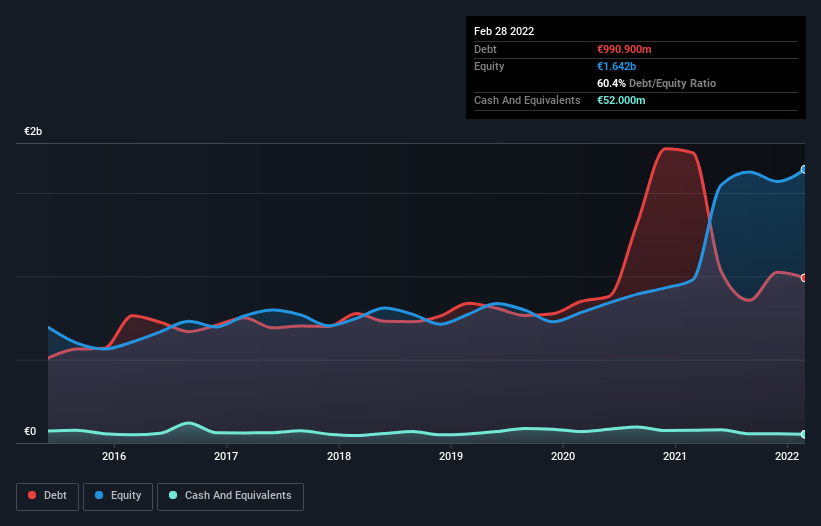Chr. Hansen Holding (CPH:CHR) Seems To Use Debt Quite Sensibly

Howard Marks put it nicely when he said that, rather than worrying about share price volatility, 'The possibility of permanent loss is the risk I worry about... and every practical investor I know worries about.' When we think about how risky a company is, we always like to look at its use of debt, since debt overload can lead to ruin. Importantly, Chr. Hansen Holding A/S (CPH:CHR) does carry debt. But the more important question is: how much risk is that debt creating?
What Risk Does Debt Bring?
Debt assists a business until the business has trouble paying it off, either with new capital or with free cash flow. If things get really bad, the lenders can take control of the business. However, a more frequent (but still costly) occurrence is where a company must issue shares at bargain-basement prices, permanently diluting shareholders, just to shore up its balance sheet. Having said that, the most common situation is where a company manages its debt reasonably well - and to its own advantage. When we examine debt levels, we first consider both cash and debt levels, together.
See our latest analysis for Chr. Hansen Holding
What Is Chr. Hansen Holding's Debt?
As you can see below, Chr. Hansen Holding had €990.9m of debt at February 2022, down from €1.74b a year prior. On the flip side, it has €52.0m in cash leading to net debt of about €938.9m.

How Strong Is Chr. Hansen Holding's Balance Sheet?
We can see from the most recent balance sheet that Chr. Hansen Holding had liabilities of €422.7m falling due within a year, and liabilities of €1.08b due beyond that. Offsetting this, it had €52.0m in cash and €229.5m in receivables that were due within 12 months. So its liabilities outweigh the sum of its cash and (near-term) receivables by €1.22b.
Of course, Chr. Hansen Holding has a market capitalization of €9.22b, so these liabilities are probably manageable. But there are sufficient liabilities that we would certainly recommend shareholders continue to monitor the balance sheet, going forward.
In order to size up a company's debt relative to its earnings, we calculate its net debt divided by its earnings before interest, tax, depreciation, and amortization (EBITDA) and its earnings before interest and tax (EBIT) divided by its interest expense (its interest cover). This way, we consider both the absolute quantum of the debt, as well as the interest rates paid on it.
Chr. Hansen Holding has net debt worth 2.3 times EBITDA, which isn't too much, but its interest cover looks a bit on the low side, with EBIT at only 6.6 times the interest expense. While that doesn't worry us too much, it does suggest the interest payments are somewhat of a burden. Importantly Chr. Hansen Holding's EBIT was essentially flat over the last twelve months. We would prefer to see some earnings growth, because that always helps diminish debt. The balance sheet is clearly the area to focus on when you are analysing debt. But it is future earnings, more than anything, that will determine Chr. Hansen Holding's ability to maintain a healthy balance sheet going forward. So if you want to see what the professionals think, you might find this free report on analyst profit forecasts to be interesting.
Finally, while the tax-man may adore accounting profits, lenders only accept cold hard cash. So it's worth checking how much of that EBIT is backed by free cash flow. During the last three years, Chr. Hansen Holding produced sturdy free cash flow equating to 70% of its EBIT, about what we'd expect. This cold hard cash means it can reduce its debt when it wants to.
Our View
The good news is that Chr. Hansen Holding's demonstrated ability to convert EBIT to free cash flow delights us like a fluffy puppy does a toddler. And we also thought its interest cover was a positive. Looking at all the aforementioned factors together, it strikes us that Chr. Hansen Holding can handle its debt fairly comfortably. Of course, while this leverage can enhance returns on equity, it does bring more risk, so it's worth keeping an eye on this one. When analysing debt levels, the balance sheet is the obvious place to start. But ultimately, every company can contain risks that exist outside of the balance sheet. To that end, you should be aware of the 1 warning sign we've spotted with Chr. Hansen Holding .
When all is said and done, sometimes its easier to focus on companies that don't even need debt. Readers can access a list of growth stocks with zero net debt 100% free, right now.
New: AI Stock Screener & Alerts
Our new AI Stock Screener scans the market every day to uncover opportunities.
• Dividend Powerhouses (3%+ Yield)
• Undervalued Small Caps with Insider Buying
• High growth Tech and AI Companies
Or build your own from over 50 metrics.
Have feedback on this article? Concerned about the content? Get in touch with us directly. Alternatively, email editorial-team (at) simplywallst.com.
This article by Simply Wall St is general in nature. We provide commentary based on historical data and analyst forecasts only using an unbiased methodology and our articles are not intended to be financial advice. It does not constitute a recommendation to buy or sell any stock, and does not take account of your objectives, or your financial situation. We aim to bring you long-term focused analysis driven by fundamental data. Note that our analysis may not factor in the latest price-sensitive company announcements or qualitative material. Simply Wall St has no position in any stocks mentioned.
About CPSE:CHR
Chr. Hansen Holding
Chr. Hansen Holding A/S, a bioscience company, develops natural ingredient solutions for the food, nutritional, pharmaceutical, and agricultural industries in Europe, the Middle East, Africa, North America, Latin America, and the Asia Pacific.
Adequate balance sheet average dividend payer.
Similar Companies
Market Insights
Community Narratives



